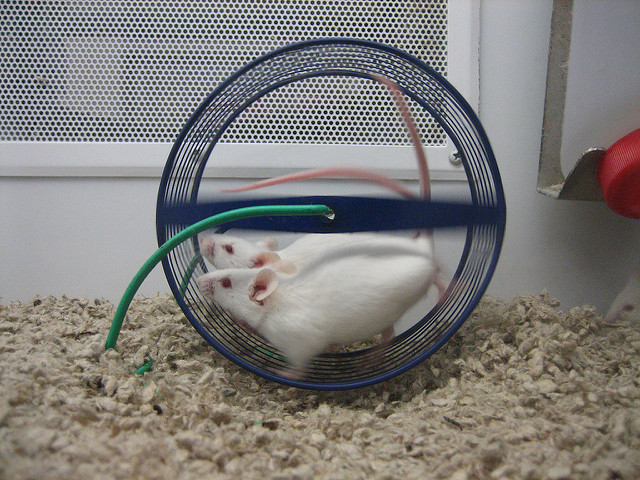Students use MRI technology to study animals’ brain activity
Photo courtesy Rene Schwietzke, Creative Commons
CNTI studies often use animal models such as mice, rats, voles, hamsters and small monkeys.
February 27, 2019
The Center for Translational NeuroImaging, or CTNI, at Northeastern provides students the ability to conduct research using powerful MRI technology.
Craig Ferris, a professor of psychology and pharmaceutical sciences, oversees 12 to 14 undergraduate students each semester as they conduct various projects, many of which they design themselves, involving animal models such as mice, rats, voles, hamsters and small monkeys.
Many research projects at CTNI focus on neurodegenerative diseases like Alzheimer’s and Parkinson’s, while others study chemotherapy in pediatrics, mild repetitive traumatic brain injury, and attention-deficit/hyperactivity disorder, or ADHD, treatments.
The lab uses magnetic resonance imaging, or MRI, technology to measure brain activity and has access to a functional magnetic resonance imaging, or fMRI, scanner. While fMRI reveals the metabolic function of the brain, MRI shows its anatomical structure.
“MRI is an incredibly powerful technology that’s being used in all health fields,” Ferris said. “It’s a non-invasive technology that can follow a brain from the time it’s here on earth until the time it dies.”
Ferris meets with the students working in his lab every Monday to discuss magnetic resonance physics and engineering. During the week, they use video conferences to keep each other updated on their progress and data accumulation. The goal of each project is to ultimately write and publish a paper.
One project team at CTNI is analyzing the effects of chronic cannabis exposure on brain activity. The team leader of the study, James Coleman, is a third-year behavioral neuroscience major, and he started at CTNI during his co-op there in July 2018.
For this study, Coleman’s team put dry herb cannabis into a vaporizer, placed mice in a box, and exposed them to the drug for 30 minutes every day for 28 days. They then scanned each mouse’s brain to look for differences in brain activity, especially between males and females. By using adolescent animals, they can identify the ways in which early chronic use of cannabis affects the development and function of the central nervous system.
“The other really cool thing that we’re doing is we’re increasing the translational value of this animal research, because when you look at the state of the literature on cannabis right now, there have been a lot of preclinical studies in animals with cannabis, but the vast majority of them have been using injected THC,” Coleman said. “And when you think about that, how does that translate to humans?”
Coleman said this marijuana study is relevant, especially in Massachusetts, because the number of recreational marijuana dispensaries in the state has been increasing since the legalization of recreational marijuana in 2016. Furthermore, it is the most frequently used illicit drug in the United States according to the National Institute on Drug Abuse
“It’s important that we have these, not only rigorous and controlled, but translatable studies in animals so we can better understand the long term effects, especially at an early age, and the long-term developmental effects associated with cannabis use,” Coleman said. “It’s really important that people have the science and have at least some idea of the actual effects on their brains, so they can know what they’re getting into if they choose to use it recreationally, medically, whatever the case may be.”

The CNTI facility is located in the Mugar Life Sciences Building.
CTNI is also conducting a diabetes study, and the team leader of this project is Chris Lawson, a fourth-year behavioral neuroscience major. Diabetes can be detrimental to an individual’s veins and arteries, so Lawson’s team hypothesized that the disease would also affect a person’s brain connectivity. For this study, the team obtained rats with Type 2 diabetes and conducted imaging protocols. Next, they will analyze the data and compare the brains of the diabetic rats to those of the control rats.
“The psychological effects of diabetes are not usually as highlighted as some of the other effects,” Lawson said. “Diabetes is a major problem that affects a lot of people, and the better we can understand it, the better treatment they can get.”
Another project at CTNI compares the effects of Adderall and Ritalin, two drugs that are prescribed to treat ADHD and are frequently overprescribed. Jack Demaree, a second-year psychology major, is the team leader of this project. He began working at CTNI during his first semester at Northeastern.
“Everybody’s there to help everybody else out,” Demaree said. “It’s a group of very highly motivated, very intelligent undergrads and it’s really fun to be a part of.”
Demaree is working on a pharmacological fMRI study, so he and his team use mice to represent a population that does not have ADHD and or prior exposure to drugs. The mice are then administered Adderall or Ritalin for three weeks and then placed into the fMRI scanner, where scans reveal brain function and activity.
“CTNI has its own scanner, which is the biggest resource possible,” Demaree said. “Getting more and more information on what these drugs can do to [an adolescent] brain and somebody who doesn’t have [ADHD] will be very helpful for future medications and diagnoses.”







